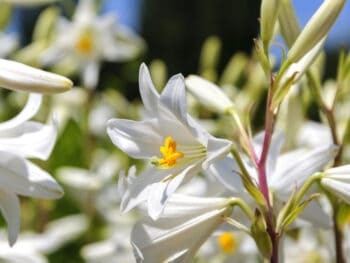It may seem as if everywhere you are hearing the buzz about pollinator gardens; that’s because the National Pollinator Garden Network is on a mission to inspire home gardeners to help support the health of pollinators. The mission objective? To increase pollinator populations, thereby securing the future of our country’s food production. Nectar- and pollen-providing landscapes of every size are a significant step to establish foraging locations across North America.
Plant a Pollinator Garden
How can you help? Plant flowers! What could be a more delightful mission?! A pollinator garden is nothing more complicated than a yard full of flowers, flowering shrubs and trees, and/or fruits and vegetables. The more, the better, and drifts or swaths of blooming plants are the most attractive…to both gardeners and our buzzy fellows…it’s a win-win endeavor!

Our feature photos reveal that bees love asparagus blossoms, dainty little blooms which appear after shoots have been harvested and those remaining have sprouted feathery leaves. I had hardly noticed these petite flourishes until I was out pollinator-scouting. To capture these photos, I followed the bee’s forage from flower to flower—completely enchanting!
Land of Milk and Honey
Of course, a busy population of bees is an age-old attraction, part of God’s promise to the Israelites of a good land:
So I have come down to rescue them from the hand of the Egyptians and to bring them up out of that land into a good and spacious land, a land flowing with milk and honey
Exodus 3:8 NIV
Hear, Israel, and be careful to obey so that it may go well with you and that you may increase greatly in a land flowing with milk and honey, just as the Lord, the God of your ancestors, promised you.
Deuteronomy 6:3 NIV
On that day I promised to bring them out of the land of Egypt to a land I had chosen for them, a land flowing with milk and honey, the most beautiful of all lands.
Ezekiel 20:6 NLV
Remember that honey, along with milk, is food for the young—sustenance for the next generation. Implied in God’s poetic description of the landscape to which the Israelites were headed was abundant forage; land filled with flowers and fodder for grazing flocks,bees gathering plenty of nectar to produce honey, thereby yielding a bounty of fruit in the land, as the natural course of flower pollination is bearing fruit. Thus, with a little license, we might say the Promised Land was one of the first pollinator gardens!
All of this speaks to flourishing sources of nourishment and a continuing provision for future generations, and resounds the original promises to Abram:
Now the Lord said to Abram, “Go from your country and your kindred and your father’s house to the land that I will show you. And I will make of you a great nation, and I will bless you and make your name great, so that you will be a blessing… in you all the families of the earth shall be blessed.”
Genesis 12:1-3 ESV
I will establish my covenant as an everlasting covenant between me and you and your descendants after you for the generations to come, to be your God and the God of your descendants after you.
Genesis 17:7 NIV
Remember the Promise
Wondering what might be a good plant to draw bees to your garden? Hyssop buzzes with bees throughout the summer, my favorite reminder of God’s promise.
Pollinator gardeners: Bees love hyssop! Tiny white flowers cover stems throughout the summer, attracting buzzing foragers and making it easy to believe that the Holy Land, covered in clumps of hyssop, was “a land of milk and honey” — plentiful pollen for bees! (Exodus 3:8, 17) Add hyssop to the garden as transplants, available from online retailers.
— from “Grow Your Faith and Your Garden with these Biblical Herbs,” The Dallas Morning News Arts & Life, April 2017
Million Pollinator Garden Challenge

Come to think of it, there were challenges in the Promised Land, struggles and battles, yet at the epic end of establishing Abram (Abraham’s) descendants was leader Joshua’s awe-inspiring declaration; may this Word be our meditation as we set out to create our gardens, mini-lands of “honey,” across our own land.:
Now I am about to go the way of all the earth. You know with all your heart and soul that not one of all the good promises the Lord your God gave you has failed. Every promise has been fulfilled; not one has failed.
Joshua 23:14 NIV
To join the Million Pollinator Garden Challenge, visit www.millionpollinatorgardens.org/
For thorough information on butterfly gardens, the other pollinators, visit The Ultimate Guide to Butterflies
Enjoy devotions exploring the promises of God in the Promised Land series, part of the Garden Tour in God’s Word for Gardeners Bible, pages a-15 & a-16
For more information on planting hyssop, find the herb in our Plant Guide, www.gardenindelight.com/plant-guide/hyssop/
Photo Credits: ©2017 Shelley S. Cramm, with special thanks to Garrett Cramm for help making the Promise of a Pollinator Garden YouTube video – I am grateful for an abundance of teenage tech help!

















Love this idea of pollinators in the garden. My hyssop had a rough winter but is coming back😊, with new sprouting throughout the garden! Will be watching the other flowers, too, for friendly bees😊